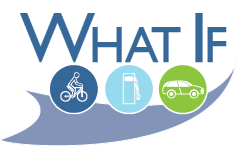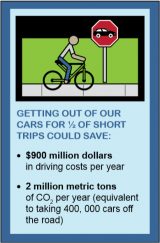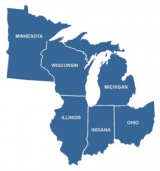What If We Kept Our Cars Parked for Trips Less Than One Mile?
 Many of us drive our cars for short trips. We drive three blocks to work out at the local gym, we drop off our teenager at a friend’s house in the neighborhood, or we move our car to park near the entrance of the next store on our list of errands. Some short car trips are necessary; for example, health and mobility issues might limit our ability to walk. Other times, driving is convenient: when we’re in a hurry, if it’s cold or raining, or if we have a lot of groceries to carry. However, some short car trips might be easily made by foot or bike.1 What if we all chose to walk or bike for just half of our car trips of under a mile?
Many of us drive our cars for short trips. We drive three blocks to work out at the local gym, we drop off our teenager at a friend’s house in the neighborhood, or we move our car to park near the entrance of the next store on our list of errands. Some short car trips are necessary; for example, health and mobility issues might limit our ability to walk. Other times, driving is convenient: when we’re in a hurry, if it’s cold or raining, or if we have a lot of groceries to carry. However, some short car trips might be easily made by foot or bike.1 What if we all chose to walk or bike for just half of our car trips of under a mile?
What's the bottom line?
Car trips of under a mile add up to about 10 billion miles per year, according to the 2009 U.S. National Household Transportation Survey (NHTS).2 That’s like the entire population of Chicago driving to Las Vegas and back! If we all chose to power half of these short trips with our feet instead of petroleum, assuming an average fuel economy of 22 mpg and an average fuel price of $2.50/gallon, we would save about $575 million in fuel costs and about 2 million metric tons of CO2 emissions per year. That’s like taking about 400,000 cars off the road each year. The total financial savings are even bigger — almost $900 million dollars — when you include savings on maintenance and tire replacement.3
What would it be like?
Every household would reap some benefits from lower driving costs, but that’s not the only perk from keeping our cars parked. Fewer car trips can improve air quality. And regular physical activity, like walking and biking, may help you lose weight, live longer, boost your mood, and reduce your risk of heart disease, diabetes, and certain cancers.4
Good For Your Health
One study found that eliminating car trips under five miles round-trip in the urban areas of Illinois, Indiana, Michigan, Minnesota, Ohio, and Wisconsin would result in almost $5 billion in health benefits associated with improved air quality.5 This same study estimated that replacing half of these car trips with bike trips could save almost $4 billion in avoided deaths and reduced health care costs by increasing physical activity.
How would we get there?
Not everyone has access to good biking and walking options, which makes it difficult for people to keep their cars parked for short trips. To facilitate more walking and biking, communities can invest in features that make these activities safe and enjoyable.
Characteristics of a walkable community include6:
- A variety of destinations within walking distance;
- Building entries in close proximity to the sidewalk;
- Pedestrian-scale building, landscape, and street design;
- Compact developments and small, walkable blocks;
- Well-connected street networks; and
- Well-designed public spaces that contribute to a great quality of life.
Community investments that can support biking include networks of bike lanes and paths, bike parking, and bike share programs.
The next time you open your car door to drive down the block, think about getting a little fresh air instead. Lace up your shoes or hop on a bike to help lower emissions, improve your health, and put more money in your pocket.
A PDF version of this page, optimized for printing
- As another example, some short car trips may be part of a much longer chain of car trips that may be difficult to substitute with walking or biking.
- U.S. Department of Transportation, Federal Highway Administration, 2009 National Household Travel Survey. URL: http://nhts.ornl.gov. The online data extraction tool (available at http://nhts.ornl.gov/det/Extraction3.aspx ) estimates 10.12 billion vehicle miles for privately owned or operated vehicles (POV) for trips under 1 mile.
- American Automobile Association (AAA), Your Driving Costs, 2014 Edition, Heathrow, FL, available at http://publicaffairsresources.aaa.biz/wp-content/uploads/2014/05/Your-Driving-Costs-2014.pdf. Exit AAA estimates maintenance and tire replacements costs for five different car types. These range from 5.45 to 6.81 cents per mile. For simplicity, we assume the maintenance and tires replacement costs are 6 cents per mile.
- For more information, visit the CDC’s website: http://www.cdc.gov/physicalactivity/everyone/health/index.html
- Grabow, et. al., “Air Quality and Exercise-Related Health Benefits from Reduced Car Travel in the Midwestern United States”, Environmental Health Perspectives, vol. 120, 2012. URL: http://ehp.niehs.nih.gov/1103440/
- These examples are based on a factsheet from the Institute for Transportation Engineers available at http://library.ite.org/pub/e1cfab33-2354-d714-5173-9d760c9adc32. Exit


